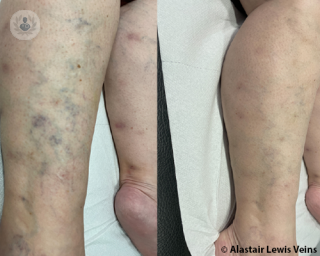Restless legs syndrome
Professor Kallol Ray Chaudhuri - Neurology
Created on: 11-13-2012
Updated on: 10-13-2023
Edited by: Sophie Kennedy
What is restless legs syndrome?
Restless legs syndrome (RLS) is a nervous system disorder that causes an irrepressible urge to get up and walk or move the legs, usually happening in the evening or night-time hours. As such, this is also considered a sleep disorder as it can cause significant sleep disruption in those with restless legs syndrome. Anyone can suffer from this syndrome, at any age, but it is more common in women and patients with diabetes, Parkinson's, renal diseases and iron deficiencies.

What are the symptoms of restless leg syndrome?
The main symptom of restless leg syndrome is the unpleasant sensation in the lower part of the legs and the irresistible urge to move the legs, which are generally worse if restless legs syndrome occurs in old age. Occasionally, the arms are also affected.
People with restless legs syndrome may experience:
- Burning sensation
- Itching
- Pain
- Palpitations
All of these symptoms make it difficult to sleep. A lack of sleep can cause daytime drowsiness, anxiety, depression, confusion or difficulty thinking clearly. Symptoms may also fluctuate in severity, and in some occasions, may disappear and then return.
What causes restless leg syndrome?
The exact cause of restless legs syndrome is not known, but there is evidence which suggests that it may be linked to dopamine, a neurotransmitter that helps to control muscle movement and activity.
Overall, restless legs syndrome can be related to other conditions such as:
- Chronic kidney disease: iron stores in the blood decrease when kidneys don't function properly
- Peripheral neuropathy: this is damage to the peripheral nerves, which contributes to restless legs syndrome
- Diabetes: uncontrolled high blood glucose levels can cause nerve damage, which may lead to diabetic peripheral neuropathy
- Lack of iron: low iron levels can result in a fall in dopamine, triggering restless legs syndrome
- Parkinson’s disease: the loss of nerve cells leads to a reduction in dopamine
- Pregnancy: although the reason is unclear, a lack of iron during pregnancy may trigger symptoms of restless legs syndrome in one in five women during the last trimester of their pregnancy - especially from week 27. In these cases, restless legs syndrome will usually disappear four weeks after delivery.
- Multiple sclerosis: damage to the nerve cells reduces the amount of dopamine
How is restless legs syndrome diagnosed?
There isn't a specific test that will diagnose restless legs syndrome. If you have symptoms of restless legs syndrome, your doctor will look at your medical history and then proceed to assess your symptoms looking for:
- A strong, overwhelming urge to move the legs along with itching or tingling
- Symptoms that get worse at night
- Symptoms that start or may worsen when resting
- Symptoms that are partially or temporarily relieved after movement in the legs
- Symptoms that aren't explained by another medical condition
Your doctor may order a physical and neurological exam to rule out other possible conditions that may be causing your symptoms. Blood tests may also be ordered. If a sleep disorder is suspected, you may be referred to a sleep specialist.
What is the treatment for restless leg syndrome?
Restless legs syndrome cannot be cured, and treatments look to relieve the symptoms. The first step in treating restless legs syndrome is making dietary and lifestyle changes as certain substances can make it worse, such as caffeine, alcohol and nicotine. Movements like stretching, walking or exercising regularly can help, as well as taking measures to reduce stress.
You can also consider using a vibrating pad on the back of the legs, or a foot wrap that is specifically designed for people with restless legs syndrome. The latter puts pressure on the feet, which may help to alleviate symptoms.
Certain medications can help severe symptoms, but are not widely prescribed for treating RLS. If there is an underlying cause such as iron deficiency, symptoms of restless legs syndrome will usually disappear with treatment.
Is restless legs syndrome an early sign for Parkinson's disease?
While people with Parkinson's disease are twice as likely to develop restless legs syndrome, there is no clear evidence that shows that restless legs syndrome develops into Parkinson's disease.
Is restless legs syndrome hereditary?
Some studies have identified genes for restless legs syndrome on chromosome sites, which suggests that the condition may run in families, particularly if it develops before the age of forty. Restless legs syndrome in elderly adults is less likely to be inherited, however.













